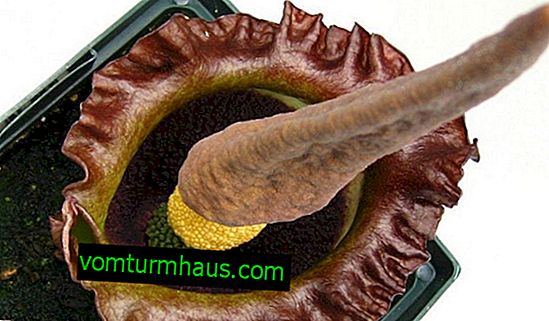Amorphophallus: description of the plant, cultivation and care at home
Among the most exotic plants that can be grown indoors, it is worth mentioning the snake palm, or Amorphophallus titanum. This rare flower is suitable for those gardeners who want to accept the challenge of nature and grow such an unusual flower at home.
Plant description
Amorphophallus titanum is a native of the Sumatra rainforest, but even there it is extremely rare. Belongs to the Aroid family. Before you see the flowering giant amorphophallus, you will have to take care of it for 10 years. The botanical name of the genus is Amorphophallus (amorphophallus). The genus has more than 100 species. Among them there are both giant specimens, and small ones, quite suitable for indoor cultivation.
Did you know? The name of the plant is translated from Greek as "shapeless escape." The plant acquired such a name because of the special form of inflorescence.
The underground part of the plant is a tuber. At rest, it can weigh up to 15 kg, and during flowering it loses up to 20% of its mass. When the titanic amorphophallus does not bloom, it releases a thick stem with a branched leaf plate. In shape, it resembles a tall trunk with an apex, like a palm tree. This property is illustrated by another popular name - the snake tree.


















During the annual growing season, the plant will throw 1 stem with a leaf plate in April and fall into a dormant period in October until the tuber reaches a weight of 9 kg, at which a young plant can bloom. Amorphophallus titanium grows in the botanical gardens of several countries. But in indoor floriculture, other, less voluminous varieties of this genus are common.
Did you know? For Europeans, the flower was discovered by Odardo Bessari (Odoardo Beccari). A nerd from Italy discovered an unusual flowering plant while traveling around Sumatra in 1878. The instance he found reached a height of 3 m.
In indoor floriculture grow:
- bell-shaped amorphophallus;

- amorphophallus cognac;

- amorphophallus bulbous and some other species.

Advantages and disadvantages
- Among the advantages of the plant are worth noting:
- its extreme exoticism;
- absolute unpretentiousness in leaving;
- attractive appearance;
- the opportunity to replenish your garden with a new pet that requires regular care;
- the opportunity to diversify your diet, since in the East, flower tubers are used for food.
- The disadvantages of amorphophallus:
- the rarity of flowering and fruiting;
- mandatory presence of a large free space and a large container for growing flowers;
- the need for an annual transplant.
Can amorphophallus be kept at home?
The plant grows quite successfully at home. The main thing is to give him enough room for growth.
Conditions of detention
The temperature graph of amorphophallus depends on the stage of vegetation. So, cold air at rest (there is only tuber in the ground) is well tolerated. But for a growing plant, a long period of cold is destructive. The optimum growth temperature is not lower than 23 ° С at night. The rainforest is a spotted light zone. Therefore, a houseplant should be located so that it does not fall in constant sunlight. The direct rays of the sun burn leaf plates.
Did you know? Before rain, the leaves of amorphophallus are covered with drops. Due to this property, the plant can confidently serve as a home barometer.
The best humidity is 80–90%. But since the usual humidity level in a room in temperate latitudes is 60%, the flower needs to be periodically sprayed from the spray gun to optimize humidity. The soil should be moist, but not moist. It is advisable to organize a small watering every other day to maintain the level of moisture. The flower prefers soil neutral in composition, with a pH of 6.0–6.5.

Landing Features
The rainforest is not only moist, but also well-drained. Therefore, do not use clay dense soils for amorphophallus. The correct soil mixture is prepared from peat and sawdust or bark. The ratio of the parts is not fundamental: 40 × 60 or 50 × 50 - any prepared mixture will be equally acceptable. At the bottom of the container for growing must be laid drainage layer. The drainage is half covered with soil mixture and the tuber is laid, covering it with the remaining soil on top. After planting, the plant should be watered.
Capacity selection
You can buy amorphophallus tuber in one of the nurseries. Usually these are 1-2 year old seedlings. The diameter of the pot under such a plant is 15–20 cm. Each next container for replanting a flower in the resting period should be 2 times wider than the previous one.
Find out if you can keep a monster flower at home.
Soil treatment
For growing snake palms, soil for aroid plants is suitable. Its main properties are friability and high nutritional value. If you prepare the soil yourself, then you should take wood bark and universal soil, mixing in approximately equal proportions. Soil before planting can be disinfected with a 1% solution of potassium permanganate or fungicides. It can be "Fitosporin", "Baikal EM-1" or any other drug used in accordance with the instructions.

Did you know? The International Union for Conservation of Nature notes amorphophallus titatium as a rare plant in Indonesia and Sumatra that is endangered.
Landing technology
Processing planting material is desirable. Bacterial spores are not visible to the naked eye, so the tuber is treated with any antibacterial drug. Most of them are based on the activity of soil bacteria. When developing, the bacteria of the drug destroy pathogenic microorganisms.

Features of growing and caring at home
Amorphophallus titanium is propagated by seeds that will grow on the cob if pollination of flowers occurs. For those who do not want to expect seeds, there is reproduction by leaf sections. 1-2 fragments taken from the outer edge of the leaf and including the y-shaped vein should be immersed in the soil and a small greenhouse should be formed using a film for the entire growing season, that is, for 9 months. Also, the plant can develop from tuber cuttings.
Fertilizing and watering
The soil in the pot must be constantly moist. During the growing period, humidity should be checked daily and water the flower as needed. The soil should look like a well-wrung sponge. Signs of excessive dryness will be dropped leaves or yellowness at the edges of the leaf, which is also a sign of the end of the growing season and the transition to a dormant period. Note that when the tuber becomes large, the soil under it will remain too dry.
Important! To check the moisture level, you can insert a finger into the soil 3-4 cm. If the finger feels moisture, the plant does not need to be watered.
And if the soil is not watered enough, then this is bad for the development of the plant. Most species of amorphophallus need careful feeding. The standard composition of minerals includes phosphorus, nitrogen and potassium in a ratio of 3: 1: 2. This amount of phosphorus is necessary for good tuber development. Fertilize during the growing season from April to October. There is no need to feed the plant during dormancy.

Pruning
At the end of the growing season, the leaves die off: they turn yellow and dry. Dry leaves need to be carefully trimmed with scissors.
Transfer
When the flower is in a dormant period, from November to March, the tuber should be transferred to a larger pot and add a new soil mixture. When moving a tuber, be careful not to accidentally damage it.
Important! Do not leave the tuber for a long time without soil, as it loses its ability to grow.
In places of damage, pathogenic microflora appears - root rot and soil pests. This can cause the death of the plant. If you will grow giant amorphophallus, then keep in mind that you need a garden cart to transport the tuber.
How is the flowering period
Giant amorphophallus is referred to as ephemeroid, since its flower blooms only a few days, and blooms 1 time in a dozen years. The inflorescence is a large yellow cob around which a veil-like leaf is wrapped. The inside of the leaf is burgundy, the outside is pale green. The cob, like the trunk, is strewn with dark green spots. Its height can reach 2.5 m, and the diameter of the sheet-bedspread is from 1 to 3 m. For the unusual structure of the flower, the people call it “voodoo lily”.

After some time, female flowers bloom on the cob, and the next night, male flowers. Intense odor is designed to attract the attention of pollinating insects. If pollination has occurred, then the fruit, consisting of red fleshy berries, begins to develop. Fruit development lasts 8–9 months. After the fruits grow, the mother tuber dies. But you can always plant the seeds and start the cycle anew.
Did you know? In order to pronounce the Latin name for amorphophallus without blushing, David Attenborough, an English naturalist and presenter of the BBC broadcast program on plants on “Private Plant Life, ” introduced the name “Titan arum”. A rum is an aronnik, a typical member of the Aroid family. From the point of view of the BBC, this name sounds less scandalous.
Possible growing problems
Amorphophallus titanium usually has no problems with insects. Spraying with soapy water perfectly destroys the sucking aphids, thrips and other insects. Root nematodes or other pests can appear on the tuber, which can be destroyed by disinfecting the tuber during the annual transplant. The treatment of the tuber and soil with fungicides prevents the development of root rot and other soil bacteria.
Growing giant amorphophallus at home is not difficult. But the biggest obstacle to this will be difficulties with getting the tuber from the nursery. It is very rare and can be damaged during transportation. Therefore, if you have a desire to grow this flower, choose one of the indoor varieties, and it will also delight you with flowering.






